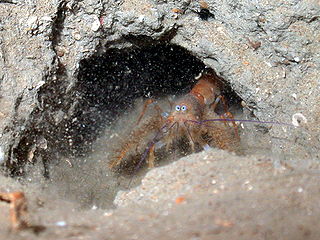
Furry lobsters are small decapod crustaceans, closely related to the slipper lobsters and spiny lobsters. The antennae are not as enlarged as in spiny and slipper lobsters, and the body is covered in short hairs, hence the name furry lobster. Although previously considered a family in their own right, the furry lobsters were subsumed into the family Palinuridae in 1990,. Subsequent molecular phylogenetics studies have confirmed that the furry lobsters genera don't form a natural group and were both nested among the spiny lobster genera in family Palinuridae. The family now includes the two furry lobster genera and ten spiny lobster genera.

Eucarida is a superorder of the Malacostraca, a class of the crustacean subphylum, comprising the decapods, krill, and Angustidontida. They are characterised by having the carapace fused to all thoracic segments, and by the possession of stalked eyes.
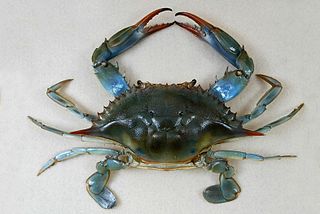
Eumalacostraca is a subclass of crustaceans, containing almost all living malacostracans, or about 40,000 described species. The remaining subclasses are the Phyllocarida and possibly the Hoplocarida. Eumalacostracans have 19 segments. This arrangement is known as the "caridoid facies", a term coined by William Thomas Calman in 1909. The thoracic limbs are jointed and used for swimming or walking. The common ancestor is thought to have had a carapace, and most living species possess one, but it has been lost in some subgroups.
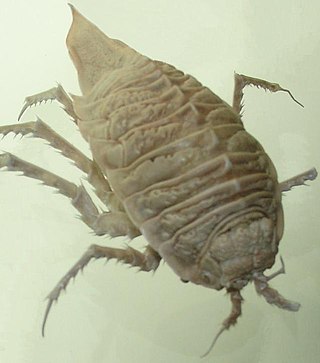
The Valvifera are marine isopod crustaceans. Valviferans are distinguished, however, by the flat, valve-like uropods which hinge laterally and fold inward beneath the rear part of their bodies, covering the pleopods. Some species are omnivorous, and serve as effective scavengers in the economy of the sea.

A woodlouse is any crustacean belonging to the suborder Oniscidea within the order Isopoda. They get their name from often being found in old wood, and from louse, a parasitic insect, although woodlice are not insects.

Albuneidae is a little-known family of specialized burrowing sand crabs. There are 50 extant species as well as nine fossil species that have been described. Fossil specimens have been described from the Cretaceous, Miocene and Oligocene.

Cheiragonidae is a small family of crabs, sometimes called helmet crabs, placed in its own superfamily, Cheriagonoidea. It comprises three extant species, Erimacrus isenbeckii, Telmessus acutidens and Telmessus cheiragonus, there are no yet evidences of Cheiragonidae in the fossil record. Many of these crabs were formerly treated as members of the Atelecyclidae.

Bresilioidea is a superfamily of shrimp. It is likely to be an artificial group, containing five families which may or may not be related.

Agnaridae is a family of woodlice. They were formerly considered part of the Trachelipodidae, but were moved from that family to Porcellionidae in 1989, and then placed as a separate family in 2003.

Stenopodidae is a family of decapods in the order Decapoda. There are about 6 genera and more than 30 described species in Stenopodidae.

Spongicolidae is a family of glass sponge shrimps in the order Decapoda. There are about 8 genera and more than 40 described species in Spongicolidae.
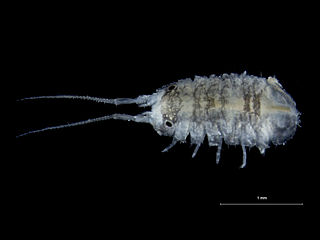
Janiridae is a family of isopods in the order Isopoda. There are more than 20 genera and 190 described species in Janiridae.

Cylisticidae is a family of woodlice in the order Isopoda. There are at least 4 genera and more than 60 described species in Cylisticidae.
Lynceidae is a family of clam shrimp in the order Laevicaudata. There are about 5 genera and more than 20 described species in Lynceidae.
Tanaididae is a family of malacostracans in the order Tanaidacea. There are about 19 genera and more than 90 described species in Tanaididae.

Bathyporeiidae is a family of amphipods in the order Amphipoda. There are two genera in Bathyporeiidae:

Helleria brevicornis, the sole species of the monotypic genus Helleria, is a terrestrial woodlouse endemic to the islands and coastal regions of the northern Tyrrhenian sea. H. brevicornis is of interest due to its endemism, unique ecology and basal position in the suborder Oniscidea.

Chydoridae is a family of water fleas in the order Anomopoda. There are more than 50 genera and 520 described species in Chydoridae. A lot of Chydoridae species are non-native species, many of which pose a great threat to aquatic ecosystems.
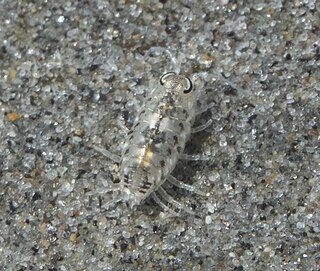
Scyphacidae is a family of woodlice in the order Isopoda. There are about 7 genera and more than 30 described species in Scyphacidae.

Halophilosciidae is a family of woodlice in the order Isopoda. There are at least 3 genera and more than 30 described species in Halophilosciidae.


















